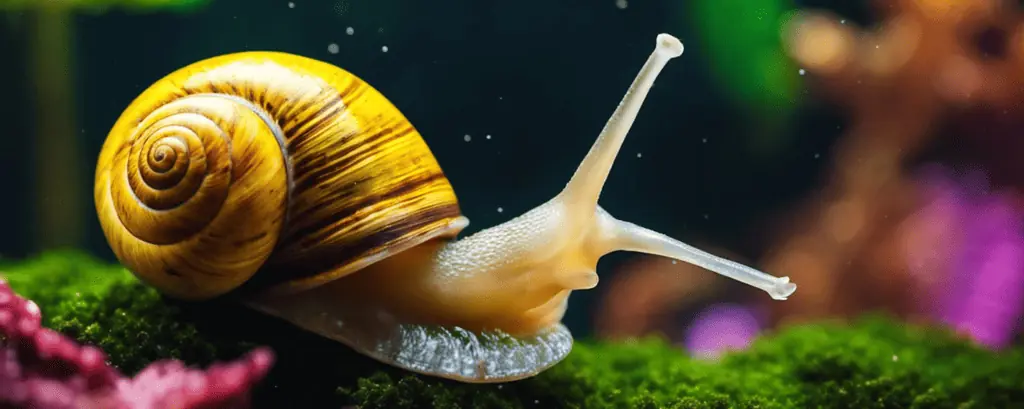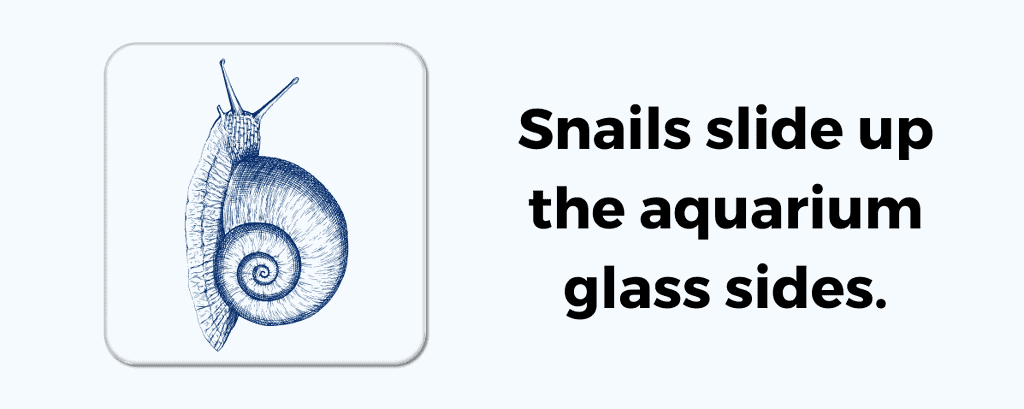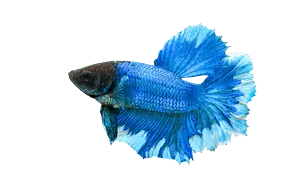Mystery snails are a great addition to your aquarium, large or small.
They help with maintenance and don’t start problems with the other aquatic life in your tank. Plus, they come in many body colors and add their personal charm to your home aquarium!
But they won’t be so great at their job if you don’t fill their needs in return.
So, here’s our mystery snail care guide to help you out.

Table of Contents
Mystery Snail Overview
| Common names | Mystery snail, spike-topped apple snail, common apple snail |
| Scientific name | Pomacea bridgesii |
| Origin | South America |
| Water type | Freshwater |
| Care level | Easy |
| Price | $4-10 per snail |
| Tank size | 5+ gallons |
| Temperament | Calm, peace-loving |
| Size | ~2“ inches |
| Diet | Herbivore |
| Dietary needs | Calcium |
| Water temperature | 68-82° degrees Fahrenheit (20-28° C) |
| pH | 7.6-8.4 |
| Hardness | 8-18 dgH, 12-18 dkH |
| Color varieties | Blue, gold, black, brown, white, purple, |
| Prevalence | Common |
| Breeding difficulty | Easy |
Mystery Snail Tank Requirements

Mystery snails are easy to care for, but we must be mindful of their needs and preferences.
Regardless of how tiny they are, mystery snails need lots of room to roam and scavenge. Ideally, you won’t keep them in an aquarium any smaller than the minimum tank size of 5 gallons.
Filtration & Substrate

Being tank cleaners, mystery snails also do well in community tanks. Of course, they aren’t a replacement for manual cleaning.
You’re still going to be responsible for water changes and substrate cleaning.
You’ll also need a filter to put in the tank.
As much as they like cleaning up food and plant waste, snails still need decent water quality to survive.
Filters help control bacteria and chemical levels in the water. If you don’t use one, you’ll have to change the tank water much more frequently.
The exact type of filter you use is up to you. But we recommend using something small with very low or easy-to-control airflow.
The other concern is what kind of substrate you use. Some fish have specific needs, but the mystery snail is pretty flexible.
Don’t use anything extremely coarse, as this is hard on their bodies. Do use something you know will provide a hard surface for them.
Having good resistance from the substrate helps your snails move more easily along the bottom of the tank.
Vegetation & Decor

There are a lot of other decorations you might put in the tank to help algae grow or entertain your snails.
Here are some of our picks:
- Hardy aquarium plants
- Rocks
- Caves
- Bubble tubes
The more densely planted your aquarium is, the happier your mystery snails will be.
They feed on food and plant waste, among other things, so adding as many plants as possible is a good call.
However, look for hardy aquatic plants because mystery snails have been known to nibble at leaves.
We have a short list of plants your snails will do well with:
- Hornwort
- Java moss/ferns
- Anubias
These are three of our favorite plants for snail aquariums. They’re tough enough to withstand some nibbling and will keep your snails happy.
Rocks are a great surface for algae to collect on. This makes it easier for your snails to access and clean up whatever algae may appear in your tank.
Caves are a good way to provide cover from predators, though many fish will never bother eating your snails.
Mystery snails sometimes burrow down in the aquarium substrate.
Caves are a way for them to hide and rest without getting into the substrate.
Bubble tubes literally send bubbles out the top for your fish and snails to play with and enjoy.
Mystery snails love them both for entertainment and because they oxygenate the water.
Tank Set-Up

Start your tank with gravel or hard sand substrate.
Before you add any water, make sure it is treated with a water conditioner/dechlorinator.
It’s also a good idea to test chemical levels, temperature, and pH before adding water to your tank. This is true when you first set the aquarium up and every time you do partial water changes.
Be generous with plants, and remember that your snails will probably slide their way up the aquarium glass at the sides of the tank.
You’re going to want a lid on your tank.
Trust me; you’ll regret leaving the tank uncovered when you find dead snails everywhere.
While mystery snails aren’t quite the notorious escape artists nerite snails are, they definitely have a tendency to disappear from the aquarium.
It’s also important not to fill the tank all the way to the top. If you leave a few inches above the top of the water, your snails will be able to hang out up there as they please.
They have breathing tubes and gills, so it’s perfectly safe for them to breach the surface.
If you plan to do any breeding, mystery snails actually lay their eggs on the side of the tank above the water’s surface.
So, either way, it is best not to fill your aquarium to max capacity.
Water Requirements
Mystery Snail Water Parameters
- pH: 7.6-8.4
- Temperature: 68-64° degrees Fahrenheit (20-28° C)
- Hardness: 8-18 dgH, 12-18 dkH
- Ammonia: 0 ppm
- Nitrate: 0 ppm
- Copper: 0 ppm
Balancing the pH and temperature of your aquarium water is important, but it’s just the first step.
Keeping an eye on ammonia, nitrate, and nitrite levels is just as important.
Having water with a lower pH or hardness level than they need will damage your mystery snail’s shell.
Specifically, you’ll see shells get soft, wear thin, and sometimes crack.
This is extremely bad for your pet’s health, so do everything possible to prevent it. They simply can’t live in soft water.
You’ll notice they can withstand a wide range of temperatures, which is convenient. But tropical tanks are their perfect environment.
Ammonia is detrimental to most kinds of aquatic life. It causes problems like fin rot in betta fish and has negative impacts on snails as well.
Unfortunately, mystery snails also produce a lot of it.
This is very manageable for avid aquarists who’ve been at it for a while.
Even if you’re more of a beginner aquarist, all you need to do is test your water more frequently.
If you notice the ammonia is creeping up toward 1-3 ppm, do more frequent water changes until it’s back under control.
Again, letting ammonia or nitrate levels get out of control will make fish, shrimp, and snails sick.
Knowing mystery snails produce lots of it is a good step toward prevention. Monitor those chemical levels!
Copper

I imagine you read copper and made a face.
But in truth, copper is fatal to mystery snails, and many people unknowingly let it get in their tank.
Some fish foods contain copper, for example. Untreated tap water sometimes has copper in it.
It doesn’t take much to kill your snails. So, test the tap water for it before you fill your aquarium.
We recommend you always treat tap water with conditioner before using it anyway.
But at the very least, you need to check it for copper and test other chemical levels as well.
Mystery Snail Diet and Feeding

Mystery snails are so beloved in the aquarist community because they are so good at cleaning up food leftovers and other kinds of waste.
A snail cannot live off leftovers alone, though.
Calcium And Healthy Shells
On top of leftover food, your mystery snails need lots of calcium in their diet.
A mystery snail with a calcium deficiency will have very poor shell health.
Some of those same problems we discussed earlier (shell thinness, cracking, or softness) are more likely to occur when there isn’t enough calcium in your snails’ diet.
They aren’t going to get nearly the amount of calcium they need simply by keeping the tank clean of algae and uneaten food.
Giving them calcium-dense veggies is a great way to mix up their diet and help them stay healthy.
They do have delicate bodies, so keep an eye on how they react to anything new you give them.
Calcium supplements are also designed for snails of all species, which work great!
Common Problems with Mystery Snails

Mystery snails aren’t particularly susceptible to any specific diseases.
But they are just as likely to suffer from stress, shock, or illness as any other species of aquarium life.
Preventing stress and shock sounds simple, but it is easier said than done.
The most important thing is to keep their water parameters stable. Even if the pH stays within a safe range, you don’t want it constantly flipping between 7.6 and 8.4.
Temperature fluctuations are hard on them as well.
You’ll have a thermometer in your tank, so just be sure to check in on the temperature from time to time.
If you notice it bouncing around a lot, there may be a problem with your heater. Get on top of any problems before they have time to get out of hand.
These are some of the most common reasons your mystery snails would feel poorly.
They do also contract parasites and other illnesses, though.
Here’s a list of common symptoms of stress, shell weakness, parasites, and other problems:
- Shell discoloration and paleness
- New spots
- Lethargy
- Hiding all day long
- Not eating
- Broken or soft shell
The first step when you see any of these things is to use a water testing strip.
If the pH or ammonia levels are not what they need to be, do a water change.
The best call is to do partial water changes a few times a week or even every day until the issue clears up.
Before you get any fish or snails, know who to call if you need help.
Whether your local vet knows something about fish or there’s a knowledgeable staff member at PetCo, having a plan in case of emergency is preferable.
Snails don’t generally live very long lives anyway, but at least someone could help you understand what’s causing problems in the tank.
What to Look for When Buying Mystery Snails

As mentioned earlier, mystery snails range in price from $4-10.
They’re available online, in pet stores, and from individual sellers who breed as a hobby.
Buying online is risky for a lot of reasons. Shipping is hard on animals of all kinds, for one thing.
Then there is the issue of not knowing the seller very well.
It is all around safer to buy in person. So, unless you really have to, we don’t recommend ordering snails online.
One thing to be careful of is the name your seller is using for their mystery snails.
Many people call mystery snails either apple snails or spike-topped apple snails, which is why we listed these earlier as common names.
Truthfully, though, apple snails are a different species that grow to be almost the size of an actual apple.
Technically apple snail is a name for mystery snails. But it’s important to double-check what kind of snail you’re getting if they are being advertised with some form of the name apple snail.
When in doubt, specify what you want by using their scientific name.
Before buying mystery snails, get a feel for whether they:
- Are healthy
- Are young/old
- Have been well cared for
- Have lived with fish before
The answer to these questions will depend largely on the seller.
But they’re critical to know how well a snail will do in your tank and how long it will likely live once you get them.
For example, understanding they have been living with poor water quality indicates they likely already have some health or shell issues.
If not, they are more at risk of developing some.
Mystery Snail Tank Mates

Avoiding Mutual Stress
Mystery snails are easily one of the most popular snail species for use in community aquariums.
This is due not only to their wonderful cleaning skills. But it is also because they are so peaceful and calm.
Even aggressive fish species are not typically bothered by mystery snails, even though these guys hang out all over the aquarium glass.
This is not to say a carnivorous fish won’t nip at or even eat your snails, though.
When introducing two species to each other, you must monitor their behavior closely.
Snails are small and relatively defenseless, so they need your help to stay safe.
Dense vegetation is already necessary for mystery snails, but it’s even more important when you add fish to the tank.
You’re giving your snails hiding places and general cover all over the tank. And you’re giving your potentially predatory fish entertainment and an obstacle course.
This is stimulating and healthy for both parties!
Caves and rocks are good choices of a substrate and are more helpful tools for protecting your snails.
Remember, the goal is always for your pets to live harmoniously.
If your snails are constantly hiding or show clear signs of stress, you may need to separate them from the aggressive fish in the tank.
Another way to prevent stress in your snails is to buy slow swimmers for the tank.
Snails are most likely to get scared when a fish swims directly at them, especially if they’re booking it!
Best Tank Mates

Provided you take these precautions, your mystery snails will make great companions to all kinds of fish.
This includes:
- Betta fish
- Small shrimp (bamboo, amano, ghost, cherry, etc.)
- Tetras
- Gouramis
- Danios
- Mollies
- Platies
- Guppies
- Goldfish
- Nerite snails
Some of these fish are more suited to live with adult mystery snails but are not so kind to baby snails.
It’s not malicious; it’s just their natural instinct. Gouramis and platies are both likely to demonstrate this behavior.
Betta fish, who we know tend to be naturally aggressive, sometimes nip at snails as well.
Depending on the specific type of danio you get, they may also be nippers. Zebra, gold ring, and celestial pearl danios are all known for being gentler options.
Note: Not all species of snails coexist harmoniously. You have to be just as picky with other snails as you are with fish species entering the tank.
Check water parameters before you add any fish to your snail aquarium.
Compromising the temperature or hardness of the water for the sake of your fish will hurt your snails and vice versa.
If mystery snails don’t fit your tank’s ecosystem, fear not! There are lots of different kinds of snails out there to choose from.
Mystery Solved
There’s a good reason mystery snails are exceedingly popular.
They do a great job cleaning up algae, plant, and food waste, though they produce ammonia.
While they are perfectly content eating leftover food and other waste from the tank, mystery snails also need lots of calcium to keep their shells healthy.
Choose your snails’ tank mates carefully, and be patient with yourselves and your pets!
We want to help snail keepers, new and old. So, if you found our article helpful or know someone who would, share it!


